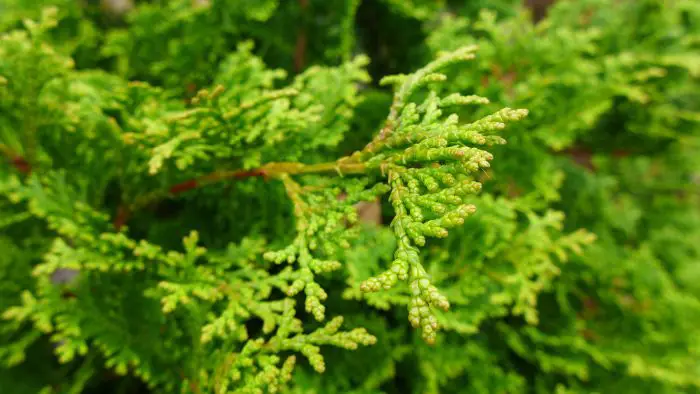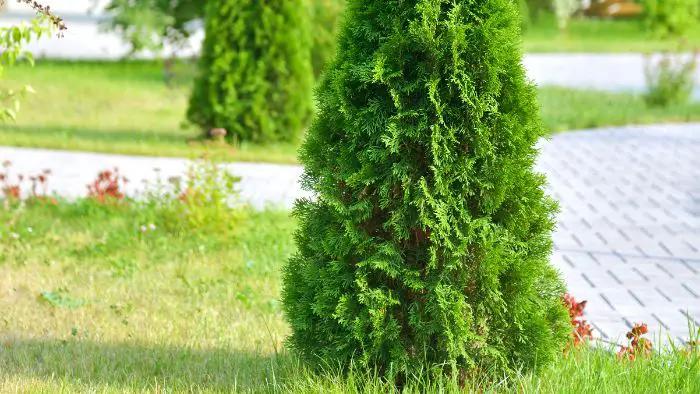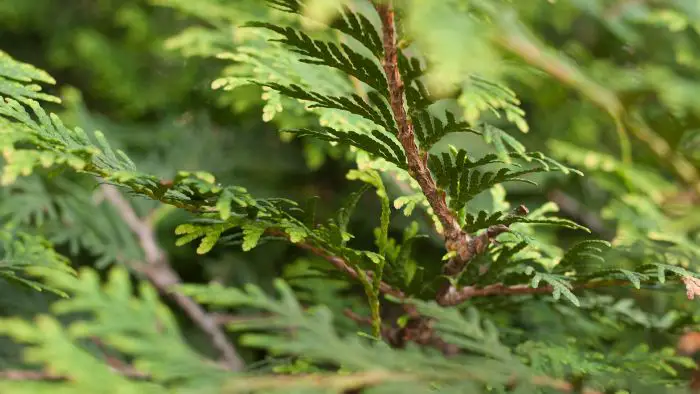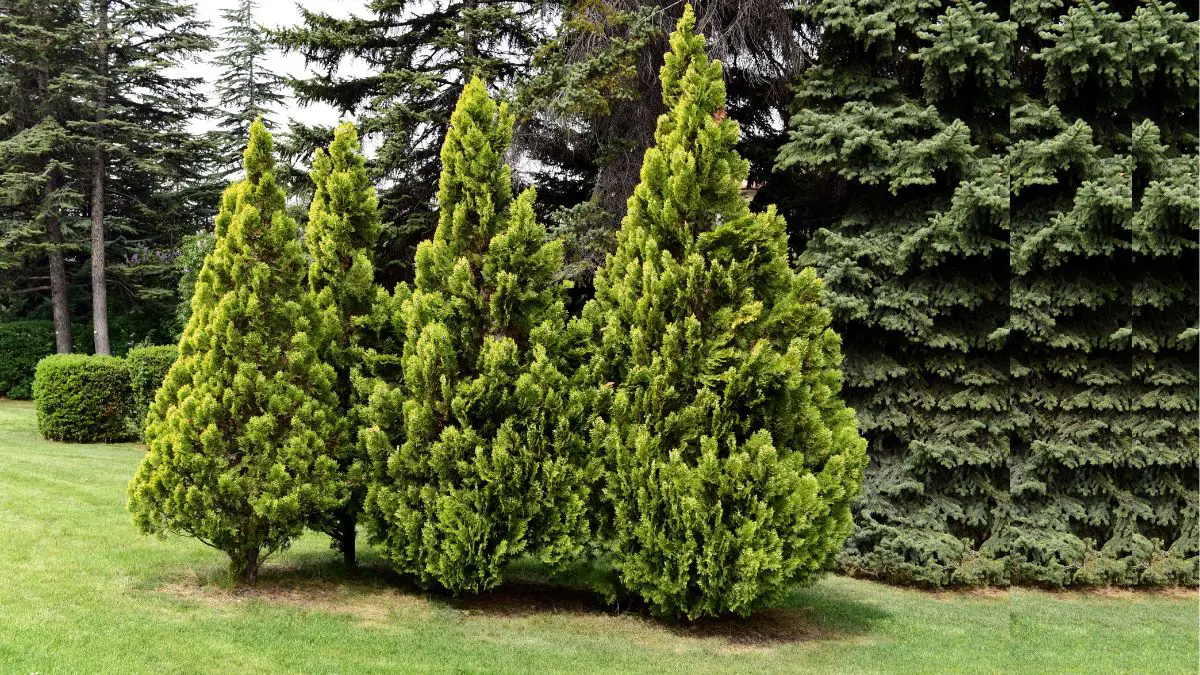Last Updated on December 6, 2022 by Guillermina
Arborvitaes are a much loved species of shrubs by homeowners for various reasons. While newly planted ones grow well in fertile soil, as the trees mature they might need some help from fertilizer to grow better. In this article, we will tell you all about the best fertilizer for arborvitaes.
What Are Arborvitaes?
Before we get the answer to the best fertilizer for arborvitaes, let us describe what they are.
Arbovitetaes, also known as thuja, are a genus of shrubs belonging to the cypress family. In this genus, there are 5 species. Three of them, i.e. Thuja koraiensis (Korean thuja), Thuja standishii (Japanese thuja) and Thuja sutchuenensis (Sichuan thuja) are native to Eastern Asia, and the other two i.e. Thuja occidentalis L. ( eastern arborvitae, northern whitecedar) and Thuja plicata (western redcedar) are native to North America.
These shrubs are evergreen trees that can grow to anywhere between 10 and 200 feet in height. They have stringy textured, reddish-brown bark.
Arborvitaes are a common shrub grown in countries in the United States. This is because of their ease of maintenance and beautiful evergreen foliage. They also have very fast growth rates, which makes them ideal for making hedges and wind breaks if needed.

Fertilizing Arborvitae
It is not recommended that you fertilize newly planted arborvitaes. The reason for this is that young arborvitaes have undeveloped and shallow root systems that are highly susceptible to burn due to high levels of fertilizer.
It is therefore best to use fertile or nutrient rich soil to plant your new arborvitaes than to give them fertilizer.
While mature arborvitaes do not necessarily need fertilizer to grow, it may benefit them.
When To Fertilize Arborvitae?
Developed, more mature arborvitaes can benefit from a fertilizer applied at the right rate. This will help the tree grow stronger, and make its foliage greener and healthier. Fertilizing the tree may also improve the overall growth rate over time.
The only time to fertilize your mature arborvitae is early in the spring season before new growth emerges from the tree. Do so because if you fertilize it at any other time, you will encourage the tree to direct its energy toward growth instead of developing the root system. Only fertilize your arborvitae once a year.

How To Fertilize Arborvitae
Fertilizing your arborvitae tree or shrub should not be a problem since these plants are not heavy feeders. Even with that, here are some factors to keep in mind with regard to fertilizing them;
- Only fertilize your arborvitae once they have grown and have established root systems, otherwise, they might experience fertilizer burn
- Apply the fertilizer only once per year in spring and no other time for efficient growth and production
- Use slow-release fertilizer that is designed for trees. Consult your local gardening expert if you are unsure which would be the best fertilizer for your arborvitae
It is important to fertilize your tree correctly to avoid negative consequences such as damage to your tree, and inefficient uptake and utilization of the fertilizer which will result in you losing money on the fertilizer.
The fertilizer bottle will often tell you how much fertilizer to give your tree, follow the directions carefully. When you apply, make sure that you distribute the fertilizer evenly over the root zone and keep it from touching the trunk of the tree.
Make sure that you drench your tree with water after applying fertilizer. This is to make sure that it gets properly dissolved so it can get efficiently taken up and utilized by the tree.
What Is The Best Fertilizer For Arborvitaes?
Now that you know when and how to fertilize your arborvitaes, let us get into what the best fertilizer for these trees is.
Nitrogen is very important for the growth and productivity of arborvitaes. The best fertilizer for these trees thref0re, in one with a high nitrogen content. Look for a fertilizer that has an NPK composition of 12-6-4 or 10-8-6 designed for evergreen trees or shrubs.
Look for powdered or granulated slow-release fertilizers as there are often very well utilized by plants. The nitrogen in these slow-release fertilizers is released slowly over a prolonged period of time. This enables you to not need to fertilize the tree too often. It also helps prevent root burn.
How To Care For Arborvitae
Practicing the right arborvitae care is important to get the best out of your trees. Providing them with the ideal growing conditions will ensure that they grow optimally.
Arborvitae prefers well-draining soils with full sunlight or partial shade. Make sure that you do not grow them in an area where they will be shielded from the sun because this will negatively impact their growth.
Keep the pH of the soil where you grow your arborvitae at 6.0 – 8.0, you can use a pH meter such as this to monitor your soil. Add good amounts of organic matter to help maintain this pH as well as the right nutrient levels and structure of the soil.
Water your newly planted arborvitaes frequently and reduce as they grow. Water deeply when you do water them and ensure that the soil never completely dries out, especially in the hot summer months.
Arborvitaes are generally low maintenance trees that do not require a lot of pruning to maintain their shape. They may however be susceptible to infestations from pests such as spider mites. These usually occur in the summer months when the soil is likely to get drier. Regular watering should help minimize this problem.
Conclusion – The Best Fertilizer For Arborvitaes
This article provided you with all the information you needed to know to get the fertilizing of your arborvitaes right. Remember that the best fertilizer for arborvitaes is one with a high nitrogen content (at least 50% of the total composition). Get one that is specifically designed for evergreen trees such as your arborvitaes. You can get these from amazon or from your local garden center, ask if you are not sure to avoid risk to your beautiful trees.
Only fertilize your trees once they are established. We hope these points and others that you have read in this article will help make your arborvitae growing journey a blissful one.
If you enjoyed this article or found it helpful, please share it with your friends and family.


An aquaculture specialist and freelance writer. Passionate about anything sustainable living, such as growing your own food, and if you can do it in conjunction with fish farming, even better! I currently work as an aquaculture researcher where I can expand and share my knowledge and skills on aquaculture, crop farming and adding value to wastewater by using it to grow food products. I enjoy reading and learning as much as possible, and writing is another avenue for me to share the knowledge I gain with others. I want my writing to inspire people to try their hand at gardening, whether indoors or outdoors. You can even start by keeping a few houseplants indoors to help you gain a bit of confidence if you need to.




